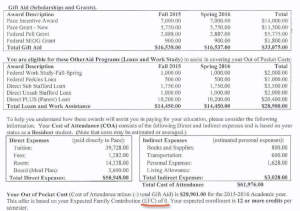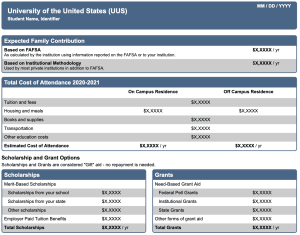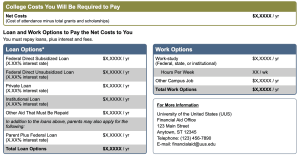Financial aid awards are often confusing.
Plenty of colleges and universities intentionally make financial aid awards hard to decipher to trick families into thinking that their institutions are being generous even when they aren’t.
Obfuscation is an effective way to keep parents from effectively evaluating a financial aid award.
Since we are in the season of financial aid letters, I wanted to show you how you can easily analyze a financial aid letter.
What Every Financial Aid Letter Should Contain
Here is what a good financial aid letter should contain:
- Full cost of attendance
- Grants and scholarships.
- Types and amounts of loans.
- Net amount student will have to pay after grants/merit scholarship deducted.
- Parent and student’s Expected Family Contribution
Most financial aid letters don’t include all these elements, which truly is an outrage. If you find a financial aid letter incomplete, you should contact the school and get the missing information.
Check the EFC
I want to especially encourage you to obtain your Expected Family Contribution from the college.
Your EFC is what the financial aid formula says your household should be able to pay for one year of college. If the EFC isn’t provided and it usually isn’t, you YOU CANNOT DETERMINE if the award is a fair one or not.
Here’s a quick background on what an EFC is:
Expected Family Contribution: 10 Things to Know
Evaluating a Financial Aid Letter
I’m using a financial letter that a parent sent me several years ago from Pace University that beautifully illustrates why knowing an EFC is critical when evaluating an award letter:
What’s Inside This Financial Aid Award

When I first saw this letter, I thought Pace University had not included this family’s EFC in the letter. I later saw that it was at the very bottom of the award without including an explanation. (I underlined it in red.)
It would have been very easy for the parents and the student not to know what this EFC figure was or why it was so important.
Before I share what the significance of this figure is, let’s take a look at what Pace was offering and not offering.
Gift aid. Pace gave this student $33,075 in grants and scholarships. In the award, $7,575 of this assistance came from the federal government (Pell and SEOG grants).
Loans and work study. After the gift aid was deducted, this student would have been expected to pay $28,900 for one year of college since the total cost of attendance was $61,976.
Evaluating this financial aid award: the verdict
Was this is a good award?
You might think so since $33,075 sure looks like a lot of free money. But in reality, this is a terrible award. The reason why I know this is because the aid letter includes the family’s EFC.
This student’s EFC is $0. This means, according to the formula, that she has the financial ability to pay $0 for college. Students get an automatic EFC when their adjusted gross income is $26,000 or less.
Pace was asking this impoverished student to pay $28,900 for one year of school. Clearly that would have been financial suicide for this low-income family to take out loans to cover this cost.
In contrast, someone with a higher EFC could have been thrilled with this type of assistance.
Let’s say a wealthy student with an EFC of $60,000 applied to Pace and got a merit award of $25,000 a year. Thanks to the merit award, the student would be paying far less than what his or her household EFC suggests the family could pay.
Know Where to Find an Applicant’s Official EFC(s)
There are three ways to identify the relevant EFC.
No. 1:
Ideally, the EFC will be included on the award letter. All schools should include this all-important figure, but as I’ve mentioned they often don’t.
No. 2:
Families can obtain the federal EFC from the federal government.
When a family files the Free Application for Federal Student Aid (FAFSA), the formula generates its official EFC. All institutions will use this EFC to determine eligibility for federal and state aid. The vast majority of colleges will also use this figure when determining whether an applicant will qualify for their own institutional aid.
A household will discover what its federal EFC is typically three to five days after filing the FAFSA electronically. That’s when they will receive a federal document called the Student Aid Report (SAR). The EFC will be displayed in the top right-hand corner of this document.
No. 3:
A household’s EFC can vary for schools that also use the financial aid application called the CSS Profile. About 200 colleges, nearly all private, use the Profile information to generate its institutional EFC for a household. This EFC is used to determine which applicants will qualify for a Profile school’s own financial aid dollars.
Profile colleges can personalize their aid formula by choosing from hundreds of optional questions, which means that each institution can generate a different EFC. Often these EFC figures will be quite similar, but there can be outliers.
If a Profile school does not provide the EFC on the award letter, you should contact each Profile institution for its EFC number.
Appeal based on the EFC
Once parents have their relevant EFC, they can appeal an award that is a disappointing one. It’s a buyer’s market at many colleges so appealing an award that an EFC indicates is inadequate can definitely be worthwhile.
Resource for Evaluating a Financial Aid Award
The best way to get up to speed on evaluating a financial aid award is to use a handy cheat sheet that shows you what a model award letter looks like.
The federal government created the cheat sheet, which is called the College Financing Plan. Until recently, it was called the Shopping Sheet. (See below).


As you can see from the screenshot of the model letter, the EFC is prominently shared at the top. With the cheat sheet, there will be no confusion about what line items are loans versus free money.
Also importantly, the award letter shares what the family’s net price would be.
The federal government would like all schools to use the template for their award letters, but many colleges have stubbornly continued to use their own flawed ones.
Bottom Line:
When a financial aid letter is incomplete, make sure you get all the information you need before making any decision about where your child will attend college and what you can afford.
And remember, you can always appeal an award!
Learn more:
The best way to lower your college costs is to become an empowered college shopper. The best way to become one is to enroll in my online course, ![]() The College Cost Lab.
The College Cost Lab.
Hundreds of high school counselors and independent college consultants have also enrolled in The College Cost Lab.
The post Evaluating a Financial Aid Letter: What’s Usually Missing appeared first on The College Solution.